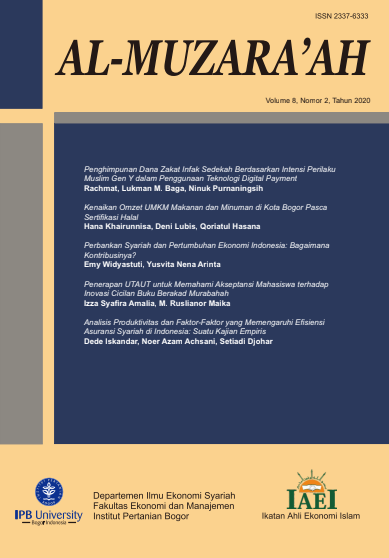Penghimpunan Dana Zakat Infak Sedekah Berdasarkan Intensi Perilaku Muslim Gen Y dalam Penggunaan Teknologi Digital Payment
Main Article Content
Abstract
The development of lifestyle generation Y is inseparable from technological development. That changes the behavior of gen Y Muslims in making zakat, infaq, shodaqoh (ZIS) payments from conventional to digital. The purpose of this study is to describe the characteristics of Muslim gen Y related to digital ZIS payments, then to analyze what influences the behavior intention of gen Y Muslims in the use of digital payment technology for ZIS payments. The results of this study qualitatively indicate that the characteristics of digital payment technology users for ZIS payments are dominated by female gen Y Muslims. The most commonly used digital payment method is transfer via mobile banking and via e-wallet. Digital service partners that are widely used to channel digital ZIS payments to OPZ are banking institutions. The quantitative research results show that the overall variables studied, namely performance expectancy (PE), effort expectancy (EE), social influence (SI), facilitating conditions (FC), hedonic motivation (HM), price value (PV), habit (HT), and perceived security (PS) have a significant influence on the behavioral intention (BI) of gen Y Muslims in the use of digital payment technology for ZIS payments, where the greatest factor influences the intention of gen Y Muslims behavior is perceived security.
Downloads
Article Details

This work is licensed under a Creative Commons Attribution-ShareAlike 4.0 International License.
Author(s) who published in this journal agree to following terms:
- Authors understand and agree that copyright of manuscripts published are held by Al-Muzara'ah. The statement to release the copyright to Al-Muzara'ah is stated in form CTA (link doc).
- Copyright encompass exclusive rights to reproduce, to distribute, and to sell any part of the journal articles in all form and media.
This work is licensed under a Creative Commons Attribution-ShareAlike 4.0 International License (CC BY-SA) where Authors and Readers can copy and redistribute the material in any medium or format, as well as remix, transform, and build upon the material for any purpose, but they must give appropriate credit (cite to the article or content), provide a link to the license, and indicate if changes were made. If you remix, transform, or build upon the material, you must distribute your contributions under the same license as the original.
References
[BAZNAS] Badan Amil Zakat Nasional. (2018). Fikih Zakat Kontekstual Indonesia. Jakarta (ID), BAZNAS.
[BPS]. Badan Pusat Statistik. (2018). Statistik Gender Tematik: Profil Generasi Milenial Indonesia [Internet]. [diakses 2019 Okt 09]. Tersedia pada: https://www.kemenpppa.go.id/lib/uploads/list/9acde-buku-profil-generasi-milenia.pdf.
Didik, M. (2019). 10 Aplikasi Pembayaran Digital yang Paling Populer Saat Ini [Internet]. [diakses 2019 Agu 17]. Tersedia pada: https://carisinyal.com/jenis-pembayaran-digital-populer/.
Hair, J. F., Black, W. C., Babin, B. J., Anderson, R. E. (2014). Multivariate Data Analysis. Seventh Edition. United States of America (1), Pearson.
Hasibuan, L. & Yulistara, A. (2018). BAZNAS: Milenial Hobi Zakat dan Beramal via Aplikasi Digital [Internet]. [diakses 2019 Okt 09]. Tersedia pada: https://cnbcindonesia.com/syariah/20180611151922-29-18777/baznas-milenial-hobi-zakat-dan-beramal-via-aplikasi-digital.
Junadi, S. (2015). A model factors influencing consumer’s intention to use e-payment system in Indonesia. Procedia Computer Science, 59, 214-220.
Khairina, N. (2019). Analisis pengelolaan zakat, infaq, dan sedekah (ZIS) untuk meningkatkan ekonomi duafa (studi kasus di Lembaga Amil Zakat Nurul Hayat cabang Medan). AT-TAWASSUTH: Jurnal Ekonomi Islam, 4(1), 160-184.
Kotler, P., Kartajaya, H., Setiawan, I. (2017). Marketing 4.0 Bergerak dari Tradisional ke Digital. Jakarta (ID), PT Gramedia Pustaka Utama.
[PUSKAS BAZNAS] Pusat Kajian Strategis Badan Amil Zakat Nasional. (2019). Indonesia Zakat Outlook 2019 [Internet]. [diakses 2019 Jul 29]. Tersedia pada: https://drive.google.com/file/d/1tNlFdA0UYJmrVVQHWNi2NesfHD_9HET/view.
Sepryna, A. (2013). Pengaruh Sikap, Norma Subjektif, dan Kontrol Perilaku yang Dirasakan terhadap Niat, serta Pengaruh Niat terhadap Kepatuhan Membayar Zakat Penghasilan. (Tesis, Universitas Indonesia, Depok, Indonesia).
Venkatesh, V., Morris, M. G., Davis, G. B., & Davis, F. D. (2003). User acceptance of information technology: Toward a unified view. MIS Quarterly, 27(3), 425 – 478.
Venkatesh, V., Thong, J. Y. & Xu, X. (2012). Consumer acceptance of information technology: Extending the unified theory of acceptance and use of technology. MIS Quarterly, 36(1), 157 – 178.
[YAKESMA] Yayasan Kesejahteraan Madani. (2019). Peran Generasi Milenial terhadap Optimalisasi Zakat [Internet]. [diakses 2019 Okt 09]. Tersedia pada: http://yakesma.org/peran-generasi-milenial-terhadap-optimalisasi-zakat/.
Yoepitasari, A. H. & Khasanah, I. (2018). Analisis pengaruh kualitas produk, promosi, dan desain produk terhadap keputusan pembelian dengan citra merek sebagai variabel intervening. Jurnal Studi Manajemen Organisasi, 15, 55-69.
Zuhdi, Z., Suharjo, B. & Sumarno, H. (2016). Perbandingan pendugaan parameter koefisien struktural model melalui SEM dan PLS-SEM. Journal of Mathematics and Its Applications, 15(2), 11 – 22.

